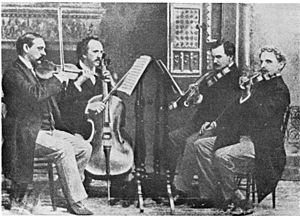Kneisel Quartet facts for kids
The Kneisel Quartet was a famous string quartet (a small group of four musicians who play string instruments) that started in Boston, Massachusetts, in 1885. For many years, it was known as the best string quartet in the United States. They even performed in Europe! The quartet played beautiful classical music until 1917.
Contents
Meet the Musicians: The Kneisel Quartet Members
A string quartet always has four members. Each plays a different string instrument. The Kneisel Quartet had a leader who played the first violin. Other members played the second violin, viola, and cello.
Here are the talented musicians who were part of the Kneisel Quartet over the years:
First Violinist: The Leader
- Franz Kneisel (1885–1917): Franz Kneisel was the leader and played the first violin for the entire time the quartet existed. He was a very important part of the group.
Second Violinists: Supporting the Melody
The second violinists helped support the main melody. Several musicians played this role:
- E. Fiedler (1885–1887)
- Otto Roth (1887–1899)
- Karel Ondříček (1899–1902)
- J. Theodorowicz (1902–1907)
- Julius Röntgen (1907–1912)
- Hans Letz (1912–1917)
Violist: Adding Depth
The viola is a string instrument similar to a violin but slightly larger and with a deeper sound.
- Louis Svećenski (1885–1917): Louis Svećenski played the viola for the entire history of the quartet.
Cellists: The Bass Voice
The cello is a much larger string instrument that provides the deep, rich bass sounds for the quartet.
- Fritz Giese (1885–1889)
- Anton Hekking (1889–1891)
- Alwin Schroeder (1891–1907)
- Willem Willeke (1907–1917)
How the Kneisel Quartet Started and Where They Played
The Kneisel Quartet began shortly after Franz Kneisel moved to Boston. He became the concertmaster (the lead violinist) of the Boston Symphony Orchestra. His training likely encouraged him to form his own quartet.
Early Performances in Boston
The quartet stayed in Boston for many years, performing at places like Chickering Hall. In 1894, they performed Dvořák's famous "American" String Quartet for the first time in Boston. They also played it in New York.
Moving to New York City
In 1903, the quartet moved its main base of operations to New York City. Sometimes, a pianist named Bertha Tapper would join them for concerts.
The End of an Era
The Kneisel Quartet stopped performing in 1917. This was because Franz Kneisel became very busy with teaching music. Their final concert was held on April 3, 1917, in New York.
Inspiring Other Musicians
The Kneisel Quartet's performances even inspired other composers. For example, Charles Ives heard them play and was inspired to write his own piece, which became his String Quartet No. 2.


